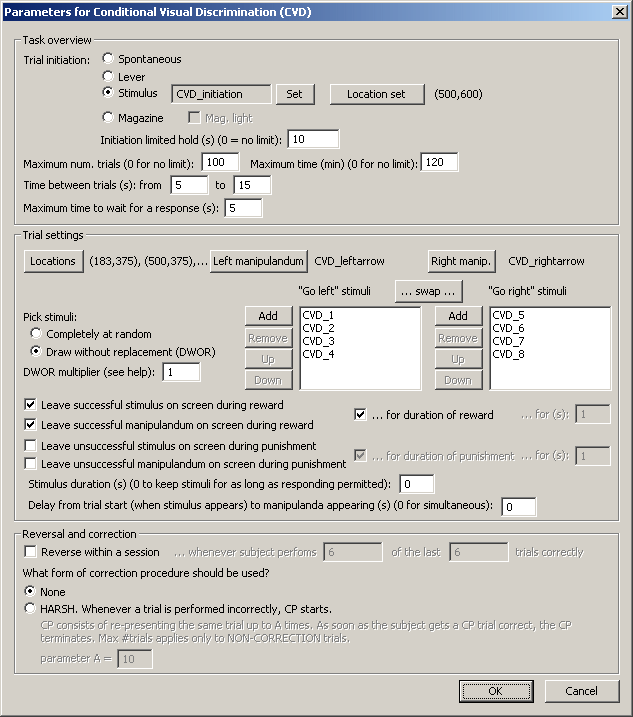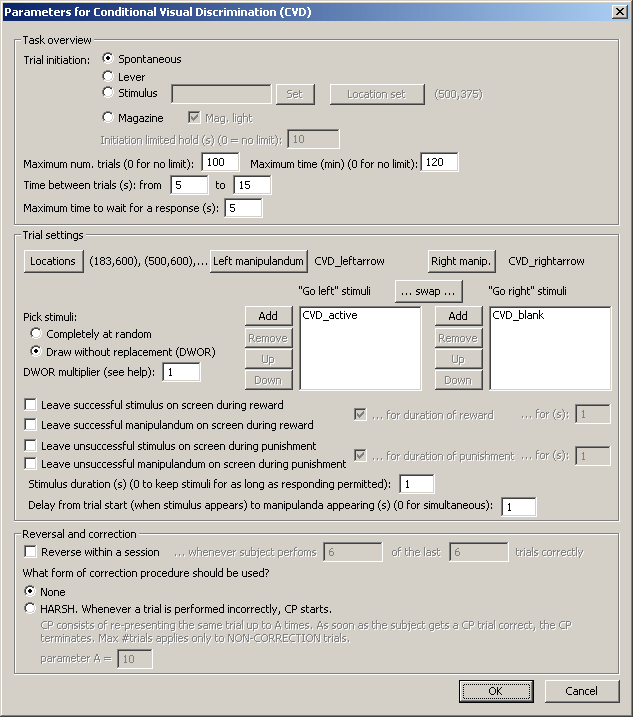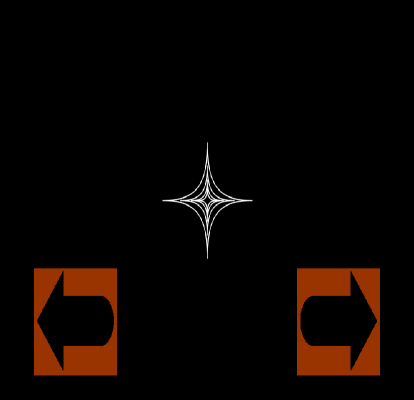Summary
Stimuli appear one by one; some require the subject to respond LEFT to win, and some require the subject to respond RIGHT.
About the task
| • | Each trial begins with a Marker 1 sound (optionally, following an initiation response). |
| • | A stimulus appears on the screen, along with two response manipulanda (left and right). It is possible to obtain reward for any stimulus, but some stimuli require a Left response, and some stimuli require a Right response. |
| • | The first response to a stimulus is registered, and the subject receives reward/punishment accordingly (or, if it fails to respond, an omission occurs and is punished). |
The stimulus can appear briefly or for as long as the subject is allowed to respond.
The stimulus (like any in MonkeyCantab) can be a blank stimulus. This allows the task to be used as a two-choice vigilance task, as follows:
- trials initiate spontaneously;
- two stimuli are used; one visible, one blank (invisible);
- the stimuli appear briefly, then the manipulanda appear;
- the subject must respond (e.g.) left for the visible stimulus, and right for the "non-stimulus"
Examples of a conventional CVD configuration, and this kind of vigilance configuration, are shown below.
Configuring the task

| • | Trial initiation. Specify the initiation method (spontaneous, requiring a lever response, requiring a response to a stimulus on a touchscreen, requiring a magazine response). For stimulus initiation, you can set its appearance and location. For magazine initiation, you can have the magazine light illuminated to indicate the need for a response. For initiation methods other than "spontaneous", specify also the initiation limited hold time (after which failure to respond causes the trial to be abandoned; use 0 for no limit). See also Use with Dogs. |
| • | Maximum number of trials. When the subject has performed this number of trials, the task ends. (You may specify 0 for no limit, though you must specify a limit on the number of trials, the time, or both. |
| • | Maximum time. When this time elapses, the task is terminated as soon as the current trial has finished. (You may specify 0 for no limit, though you must specify a limit on the number of trials, the time, or both.) |
| • | Time between trials. Specify a minimum and a maximum intertrial time (they may be the same). The actual time is chosen with a rectangular probability distribution within these values. The time between trials starts after any reward or punishment from the previous trial has finished. |
| • | Maximum time to wait for a response. Once the response manipulanda have been presented, this is the time that the program will wait for a response before abandoning the trial as an omission. |
| • | Locations. Click to choose the Locations used for the stimuli. The three locations are considered, in order: LEFT (for the left manipulandum), CENTRE (for the stimulus), and RIGHT (for the right manipulandum). |
| • | Left and right manipulanda. Choose the stimuli to be used for the manipulanda. |
| • | Pick stimuli... This can be (a) completely at random, in which a stimulus is drawn at random from the combined "go-left" and "go-right" lists (with replacement); (b) draw-without-replacement (DWOR). In DWOR, the task creates a combined 'pool' of "go-left" and "go-right" stimuli, created by taking the go-left and go-right lists and making as many copies of them as the DWOR multiplier, which you specify. On each trial, a stimulus is drawn without replacement from this pool. The pool is re-created when it is empty. See also randomness, pseudorandomness, and drawing without replacement. |
| • | "Go-left" and "go-right" stimuli. Specify your list of "go-left" and "go-right" stimuli. There is a button to swap the sets. |
| • | Leave successful stimulus/manipulandum on during reward? (etc.) When the subject responds successfully, the stimulus and/or manipulandum can be left on the screen during reward. When the subject responds unsuccessfully, the stimulus and/or manipulandum can be left on the screen during punishment. These things can either be left on for the duration of the reward/punishment (as specified in the General Parameters), or you can specify how long to leave them on the screen for. |
| • | Stimulus duration. The stimulus begins when the trial starts (immediately upon trial initiation, as defined above). Specify the stimulus duration, or zero to have the stimulus remain on-screen for as long as the response manipulanda do. |
| • | Delay from trial start to manipulanda appearing. A delay can be added between the trial start (when the stimulus appears) and the response manipulanda appearing. (The manipulanda then remain on screen for the "maximum time to wait for a response", as above.) |
| • | Reverse within a session. Optionally, the contingencies (whether a stimulus is "go-left" or "go-right") can be reversed (for all stimuli simultaneously) during the session, whenever the subject performs X of the last Y trials correctly. Specify the X and Y. (When a reversal occurs, the requirement is reset.) |
| • | Correction procedure. A correction procedure can be applied if desired. In the "harsh" technique, the correction procedure begins whenever a trial is performed incorrectly; the trial is re-presented up to A times or until the subjects responds correctly. Specify the parameter A. |
Example of CVD configured as a vigilance task
The screenshot above shows the CVD set up in conventional fashion. Here's an example of the CVD set up as a vigilance task; in this example, the trials begin spontaneously, the stimulus (or "non-stimulus") appears for 1 second, and then the respond manipulanda appear for up to 5 seconds. Note also that you can vary the proportion of stimulus and non-stimulus trials; for example, to have a 3:2 ratio of stimuli to non-stimuli, enter 3 copies of the stimulus in one list and 2 copies of the non-stimulus in the other list.

Screenshot

See Signal Detection Theory for notes on analysis.